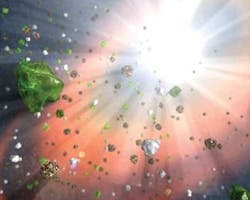ASTRONOMY: Quasar produces dust (and jewels) in the wind

The highly energetic center of a quasar seems to be the source of a lot of cosmic dust-and even some microscopic jewels.1 The dust was found by astronomers using NASA’s Spitzer Space telescope to examine a far-off quasar-a superactive and incredibly luminous young galaxy with a black hole at its center. The findings are a significant new clue in an old mystery: where did all the dust in the very early universe come from?
Hydrogen and helium were postulated to be the earliest ingredients in the universe, results of the Big Bang that clumped to form stars. Nuclear fusion inside the hot dense cores of the first stars formed the heavier elements, and the first dust particles would have formed as the first supernovas exploded long ago. But when astronomers look back to the earliest and farthest reaches of the universe, more dust was found than could have been produced by early supernova.
“We know additional sources of dust must be present,” says lead astronomer Francisca Markwick-Kemper of the University of Manchester in England. The question is, where and what are these sources? Theorists have long guessed that quasars could be the answer; the winds coming off the accretion disks surrounding the central black holes in quasars provide the right conditions for dust formation.
So Markwick-Kemper and her team directed Spitzer to the quasar PG 2122 +059, located at the center of a galaxy 8 billion light-years away. They chose this quasar for its broad blue-shifted absorption, indicative of an outflowing wind. They used the low-resolution modules of Spitzer’s infrared spectrograph to obtain spectra at wavelengths between 5.2 and 38.0 μm.
The team found thermal emission spectra of amorphous silicates such as olivine, also known as magnesium iron silicate or (Mg,Fe)SiO4,with a low iron content of 5%; and fayalite, or iron silicate (FeSiO4). Olivine and fayalite are glass-like compounds commonly found in the local interstellar medium.
Fosterite surprise
But a surprising component in the dust is forsterite (magnesium silicate or MgSiO4)-a crystalline silicate found in the green gem peridot and never before reported in quasars (see figure). Crystalline silicates are not found in the interstellar medium of our own galaxy; they are destroyed by cosmic rays over time back to amorphous states. The presence of 5% ± 3% by weight fraction of crystalline silicates around PG 2112 +059 requires high temperatures such as those found in the immediate quasar environment to counteract this destruction.
The researchers also detected the unusual ingredients periclase (magnesium oxide or MgO), a rocky mineral used in refractory bricks; and corundum, (aluminum oxide or Al2O3), the crystal that makes up rubies and sapphires. While periclase and corundum are common in other astrophysical environments, their presence around a quasar is not-setting apart the dust in PG 2112 +059.
The mixed olivine and corundum composition provides the first direct evidence for a clumpy density structure in the dust-forming regions of quasars, because some pockets of wind must be of low-enough density to prevent silicates from forming on top of the corundum, while other pockets have high enough density to allow it. Furthermore, the presence of periclase next to magnesium-rich olivines indicates that the gas cooled rapidly enough to allow their formation at the same time. These mixed observations suggest that the dust must have been newly minted in the quasar winds.
“This is the first time the composition of the dust entrained in nearby quasar winds has been determined, thus shedding light on the origin of the first dust in the universe,” says Markwick-Kemper.
REFERENCES
1. F. Markwick-Kemper et al., Astrophysical J. Lett. (Oct. 20, 2007).

Valerie Coffey-Rosich | Contributing Editor
Valerie Coffey-Rosich is a freelance science and technology writer and editor and a contributing editor for Laser Focus World; she previously served as an Associate Technical Editor (2000-2003) and a Senior Technical Editor (2007-2008) for Laser Focus World.
Valerie holds a BS in physics from the University of Nevada, Reno, and an MA in astronomy from Boston University. She specializes in editing and writing about optics, photonics, astronomy, and physics in academic, reference, and business-to-business publications. In addition to Laser Focus World, her work has appeared online and in print for clients such as the American Institute of Physics, American Heritage Dictionary, BioPhotonics, Encyclopedia Britannica, EuroPhotonics, the Optical Society of America, Photonics Focus, Photonics Spectra, Sky & Telescope, and many others. She is based in Palm Springs, California.